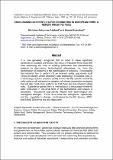| dc.description.abstract | It is now generally recognized that in order to make significant
advances in accident prevention, the focus of industrial firms must shift
from assessing the risks of existing production and manufacturing
systems to discovering technological alternatives, i.e. from the
identification of problems to the identification of solutions. Encouraging
the industrial firm to perform (1) an inherent safety opportunity audit
(ISOA) to identify where inherently safer technology is needed, and (2)
a technology options analysis (TOA) and to identify specific inherently
safer options will advance the adoption of primary prevention strategies
that will alter production systems so that there are less inherent safety
risks. Experience gained from a methodology to encourage inherently
safer production in industrial firms in the Netherlands and Greece is
discussed. Successful approaches require both technological and
managerial changes. Firms must have the willingness, opportunity,
and the capability to change. Implications for the EU Seveso, IPPC,
and EMAS Directives are also discussed. | en_US |
